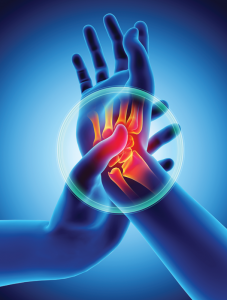Carpal tunnel syndrome afflicts those who use repetitive motion
By Jessica Arsenault Rivenburg
 Carpal tunnel syndrome is the most common nerve disorder, affecting millions of adults in the United States.
Carpal tunnel syndrome is the most common nerve disorder, affecting millions of adults in the United States.
Symptoms range from mild and occasional numbness in the fingers, a burning sensation and hand weakness, to loss of feeling and hand function. It is also very treatable and can often be avoided.
CTS occurs when swelling in the carpal tunnel — a tunnel formed by eight small wrist bones and a ligament through which a nerve and tendons pass — squeezes and restricts the impulses of the median nerve as the result of a traumatic injury or prolonged repetitive motion. Most of the time people who got injured in an auto accident gets it, especially when the victims try to brace and protect themselves.
The smaller the carpal tunnel is to begin with, the more likely CTS will develop. For this reason, the majority of sufferers are women, who naturally have narrower wrists than men.
CTS has long been associated with the office setting. Prolonged use of a mouse and keyboard can lead to carpal tunnel swelling. But any highly repetitive task performed day in and day out can serve as a culprit, from gardening and cooking, to excessive texting, said Amy Manning, physical therapist at SECO Physical Therapy in Ilion.
If CTS gets bad enough, patients may undergo surgery to correct the issue. But more often, a few simple steps like stretching and icing can mitigate CTS or prevent it all together, Manning said.
Alleviate wrist pain
• Take breaks: Manning advises patients to be cautious about performing high-risk activities and to take breaks.
“Switch off tasks so you’re not in the same position for a long time,” she said. “Get up and stretch or do something else for a bit, and then return to the task.”
• Practice good posture: “Good posture is key,” Manning said.
Finding a chair at the correct height for your size to keep the computer screen at eye level, keeping elbows down and on arm rests, sitting up with your back straight, keeping shoulders relaxed and your feet flat on the floor are all important factors in avoiding pain. If the pain eventually travels up your arm even with all these measures then you should seek wrist and shoulder pain treatment, possibly from a physical therapist or Pain Specialists. In addition, to address soft tissue and musculoskeletal issues, instrument-assisted Soft Tissue Mobilization is used in physical therapy.
• Stretch: “There are a handful of simple stretches you can do to keep things loose and relieve tightness,” Manning said. “For one, you can do this throughout the day at your desk: Place your palm down on the desk and bend your hand back and up so your fingers are pointing toward the ceiling. Use your other hand to gently pull them back further.”
Another stretch involves holding your arm out straight and flexing your hand and wrist on and off for a few seconds.
• Braces: There exist a number of styles and brands of wrist braces that can be worn while working, and others designed to be worn while sleeping that guide and hold the wrist into a neutral position and provide support, Manning said. Braces can be found in local drug stores or online.
• Proper equipment: “A chair set at the proper height and an ergonomic keyboard can be key in preventing swelling and discomfort,” Manning advised.
There is ergonomic equipment available for many fields of work, as suggested, from keyboards and mouse pads to gardening tools and power tools, all designed to help the user keep their arms, wrists, hands and neck in proper alignment and reduce strain.
“A quick internet search will find you dozens of options,” Manning said.
• Seek medical assistance sooner than later: “If you’re feeling tightness and fatigue in your wrist, immediately start taking breaks, stretching and using ice rather than heat,” Manning urged. “And if there is any numbness and tingling, that means the nerve is involved and you should seek medical assistance.”
“There are more aggressive stretches and strengthening exercises you can do in physical therapy or electric stimulation,” she added. “But if you ignore it and keep going, you could injure yourself further so that the only answer is surgery.”

